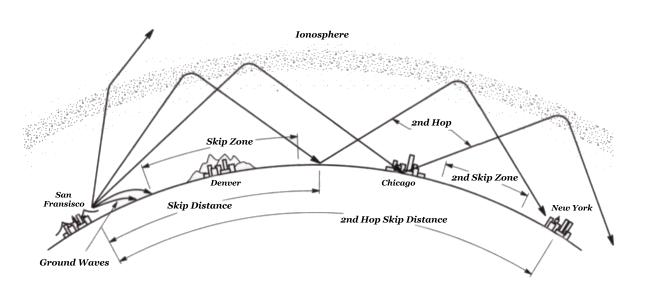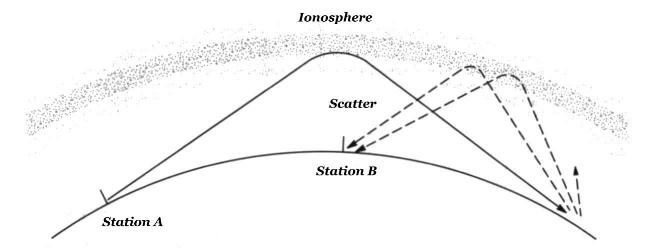
What is Radio Propagation: RF Propagation
The sun has a large effect on long-distance radio communication on Earth. Solar flares, as well as sun spots, can make long-distance communication possible . . . or impossible.
Amateurs enjoy the privilege of using many different frequency bands. Some of these are scattered throughout the high frequency (HF) spectrum, and others extend across the very high frequency (VHF) and ultra high frequency (UHF) bands.
Some of the bands work better during the day and some better at night. Some frequencies are good for long-distance communications, while others provide reliable short-range communications. Amateurs who want to work a certain part of the country or world need to know which frequency to use and when to be there. Experience from lots of careful listening is a good way to gain this knowledge.
Radio waves generally travel to their destination in four ways:
- Directly from one point to another.
- Along the ground, bending slightly to follow the curvature of the Earth for some distance.
- Traveling a longer distance than normal before coming back to the Earth's surface, because they are trapped in a layer of the Earth's atmosphere.
- Refracted, or bent, back to Earth by the ionosphere. (The ionosphere is a layer of charged particles called ions, in the Earth's outer atmosphere. These ionized gases make long-distance radio contacts possible on the HF bands.)
Propagation is the study of how radio waves travel from one point to another, and can be a fascinating part of ham radio.
When signals travel directly from the transmitting antenna to the receiving antenna, this is referred to as line-of-sight propagation. These direct waves are useful primarily only in the very high frequency (VHF) and ultra high frequency (UHF) bands. TV and FM radio broadcasts are received as direct waves.
When you transmit on a local repeater frequency, direct waves generally travel in a straight line to the repeater. The repeater then sends the signals, in a straight line, to other fixed, portable, and mobile stations. When using a handheld transceiver to communicate with another nearby ham, the signals also travel in a straight line.
When you operate on the VHF and UHF you usually will be contacting nearby stations within 100 miles or so. Because the signal travels directly between stations, if you are using a directional antenna, you normally point it toward the station you are trying to contact.
VHF and UHF signals are easily reflected by buildings, hills, and even airplanes, so some of your signal reach the other station by a direct path and some may be reflected. When reflections occur, it is possible to contact other stations by pointing your antenna toward the reflecting object rather than directly at the station you are trying to contact.
In mobile operations when the propagation paths are constantly changing, reflections can cause problems. The direct and reflected waves may first cancel and then reinforce each other. This causes a rapid fluttering sound called picket fencing.
The most distant point you can see when the sky is clear is called the visible horizon. It is only limited by the height of the observer above ground. From the top of a mountain you can see much farther than the 8 or 9 miles you can see over flat ground or water.
The troposphere consists of atmospheric regions close to the Earth's surface. Slight bending of radio waves occur in the troposphere, causing signals to return to Earth beyond the geometric horizon, and allows you to contact stations that are farther away than would otherwise be possible. This radio path horizon is generally about 15% farther away than the visible horizon.

Tropospheric bending is evident over a wide range of frequencies, although it is most useful in the VHF/UHF region.
Radio signals can be trapped in the troposphere, traveling a longer distance than normal before coming back to the Earth's surface. Usually the warmest air is close to the Earth, and the temperature and air pressure decreases as you go higher. Instead of gradual changes in air temperature, pressure and humidity, sometimes distinct regions may form in the troposphere. Adjacent regions that have significantly different densities will bend radio waves passing between regions.
During the spring, summer, and fall months, it is possible to make VHF and UHF contacts over long distances up to 1,000 miles or more. This occurs during certain weather conditions that cause tropospheric enhancement and tropospheric ducting. It is most useful in the VHF/UHF region.
When such "tropo" openings occur, the VHF and UHF bands are filled with excited operators eager to work DX. The troposphere is the layer of the atmosphere just below the stratosphere. It extends upward approximately 7 to 10 miles. In this region clouds form and temperature decreases rapidly with altitude.
Under normal conditions, the temperature of the air gradually decreases with increasing height above ground. When there is a stable high-pressure system, a mass of warm air may overrun cold air, causing a temperature inversion. Radio waves trapped below the warm air mass can travel great distances with little loss. The area between the Earth and the warm air mass is known as a duct.

As radio waves travel through the troposphere, there will always be some signal loss. For any particular path through the troposphere, the signal loss increases as the frequency increases.
Tropospheric ducting is the most common type of enhanced propagation at UHF. Ducts usually form over water, but they can also form over land. A wide spread temperature inversion formed over an ocean may help your VHF or UHF signals travel several hundred miles. Tropospheric ducting supports contacts of 950 miles or more over land and up to 2,500 miles over oceans.
In ground-wave propagation, radio waves travel along the Earth's surface and even over hills, following the curvature of the Earth for some distance. AM broadcasting signals travel by way of ground-wave propagation during the day. Ground wave works best at lower frequencies. During the day you might have an 80 meter QSO with a station only a few miles away, on the other side of a hill. For that contact, you are using ground-wave propagation.
Ground-wave propagation on the ham bands means relatively short-range communications. Stations at the high frequency (HF) end of the AM broadcast band (the 1,600 kHz end) generally carry less than 100 miles during the day, but stations near the low frequency end can be heard up to 100 miles away. Amateur Radio frequencies are higher than the AM broadcast band, so the ground-wave range is even shorter.
The Earth's upper atmosphere (25 - 200 miles above the Earth) consists mainly of oxygen and nitrogen. There are traces of hydrogen, helium, and several other gases. The atoms making up these gases are electrically neutral: they have no charge and exhibit no electrical force outside their own structure. The gas atoms absorb ultraviolet radiation and other radiation from the sun. This knocks electrons out of the atom. These electrons are negatively charged particles, and the remaining portions of the gas atoms form positively charged particles. The positive and negative particles are called ions. The process by which ions are formed is called ionization.
When ionized by solar radiation, this region, called the ionosphere, can refract (bend) radio waves. If the wave is bent enough, it returns to Earth. If the wave is not bent enough, it travels off into space. Ham radio contacts of up to 2,500 miles are possible with one skip off the ionosphere. Worldwide communications using several skips can take place if conditions are right. This is the way long-distance radio signals travel.
Two factors determine sky-wave propagation possibilities between two points: the frequency in use and the level of ionization. The higher the frequency of the radio wave, the less it is bent by the ionosphere. The highest frequency at which the ionosphere bends radio waves back to a desired location on Earth is called the maximum useable frequency (MUF). The MUF for communication between two points depends on solar radiation strength and the time of day. Radio waves that travel beyond the horizon by refraction in the ionosphere are called sky waves. Sky-wave propagation takes place when a signal is returned to Earth by the ionosphere.
Ionization of the ionosphere results from the sun's radiation striking the upper atmosphere. It is greatest during the day and during the summer. The amount of radiation coming from the sun varies through the day, season, and year. The radiation is closely related to visible sunspots (greyish-black blotches on the sun's surface). Hams interested in long-distance communication always know what part of the sunspot cycle we are in. Sunspots vary in number and size over an 11 year cycle. More sunspots usually mean more ionization of the ionosphere.
When sunspots are low, radiation and the MUF are lower. That is why HF communication is enhanced during times of greater sunspot activity.
Skip propagation has both a maximum and minimum range limit. That minimum is often greater than the ground-wave range. There is an area between the maximum ground-wave distance and the minimum skip distance where radio signals on a particular frequency will not reach. This "dead" area is called the skip zone.

There are several ionized regions which appear at different heights in the atmosphere. Each region has a central region where the ionization is the greatest. The intensity of the ionization decreases above and below the central area in each region.

The ionosphere consists of several regions of charged particles. These regions have been given letter designations. Scientists started with the letter D just in case there were any undiscovered lower regions.

The D region:
The lowest region of the ionosphere affecting propagation is the D region. This region is in a relatively dense part of the atmosphere about 35 - 60 miles above the Earth. When atoms in this region absorb sunlight and form ions, the ions don't last very long. They quickly combine with free electrons to form neutral atoms again. The amount of ionization in this region varies widely, as it depends on how much sunlight hits the region. At noon, D region ionization is maximum or very close to it. By sunset, this ionization disappears. The D region is ineffective in refracting or bending high-frequency signals back to Earth. The D region's major effect is to absorb energy from radio waves. As radio waves pass through the ionosphere, they give up energy which sets some of the ionized particles into motion. Effects of absorption on lower frequencies are greater than on higher frequencies. Absorption also increases when there is more ionization. The more ionization, the more energy the radio waves lose passing through the ionosphere. Absorption is most pronounced at midday. It is responsible for the short daytime communications ranges on the lower-frequency bands (160, 80, and 40 meters).
The E region:
The next region in the ionosphere is the E region, at an altitude of 60 to 70 miles. At this height, ionization produced by sunlight does not last very long. This makes the E region useful for bending radio waves only when it is in sunlight. Like the D region, the E region reaches maximum ionization around midday. By early evening the ionization level is very low. The ionization level reaches a minimum just before sunrise, local time. Using the E region, a radio signal can travel a maximum distance of about 1,250 miles in one hop. Sporadic E or E skip, is a type of sky-wave propagation that allows long-distance communications on the VHF bands (6 meters, 2 meters, 222 MHz). Although, sporadic E only occurs during certain times of the year, it is the most common type of VHF sky-wave propagation.
The F region:
The region of the ionosphere most responsible for long-distance amateur communication is the F region. This region is very large and ranges from about 100 to 310 miles above the Earth. The height depends on season, latitude, time of day, and solar activity. Ionization reaches a maximum shortly after noon local standard time, and tapers off very gradually towards sunset. At this altitude, the ions and electrons recombine very slowly. The F region remains ionized during the night, reaching a minimum just before sunrise. After sunrise, ionization increases rapidly for the next few hours. Then it increases slowly to its noon time maximum.
During the day, the F region splits into two parts, F1 and F2. The central part of F1 region forms at an altitude of about 140 miles. For the F2 region, the central region forms at about 200 miles above the Earth. These altitudes vary with the season of the year and other factors. At noon in the summer the F2 region can reach an altitude of 300 miles. At night, these two regions recombine to form a single F region slightly below the higher altitude. The F1 region does not have much to do with long-distance communications. Its effects are similar to those caused by the E region. The F2 region is responsible for almost all long-distance communication on the amateur HF bands. A one-hop radio transmission travels a maximum of about 2,500 miles using the F2 region.
Scattering influences all electromagnetic-wave propagation. This alters the idealized patterns to a great degree. The Earth's atmosphere, ionospheric regions, and any objects in the path of radio signals scatter the energy. By understanding how scattering takes place, we can use this propagation mode to our advantage.
There is an area between the outer limit of ground-wave propagation and the point where the first signals return from the ionosphere. The skip zone is often described as if communications between stations in each other's skip zone were impossible. But, some of the transmitted signal is scattered in the atmosphere, so the signal can be heard over much of the skip zone. You usually need a very sensitive receiver and good operating techniques to hear these signals, as they are usually weak and distorted.
You can observe a complex form of scatter when you are working very near the MUF. The transmitted wave is refracted back to Earth at some distant point. A portion of the transmitted signal reflects back into the ionosphere. Some of this signal comes toward the transmitting station. The reflective wave can help fill the skip zone.

Scatter signals are generally weak and subject to distortion, because the signal can arrive at the receiver from many different directions. This type of scatter propagation is usable from just beyond the local range out to several hundred miles.
Under ideal conditions, scatter propagation is possible over 3,000 miles or more. This form of propagation is sometimes called "backscatter", but the term "sidescatter" is more descriptive of what happens on such long paths.
By Jonathan Imberi
Originally appears at: www.pac-attack.com/articles/radio-wave-propagation















